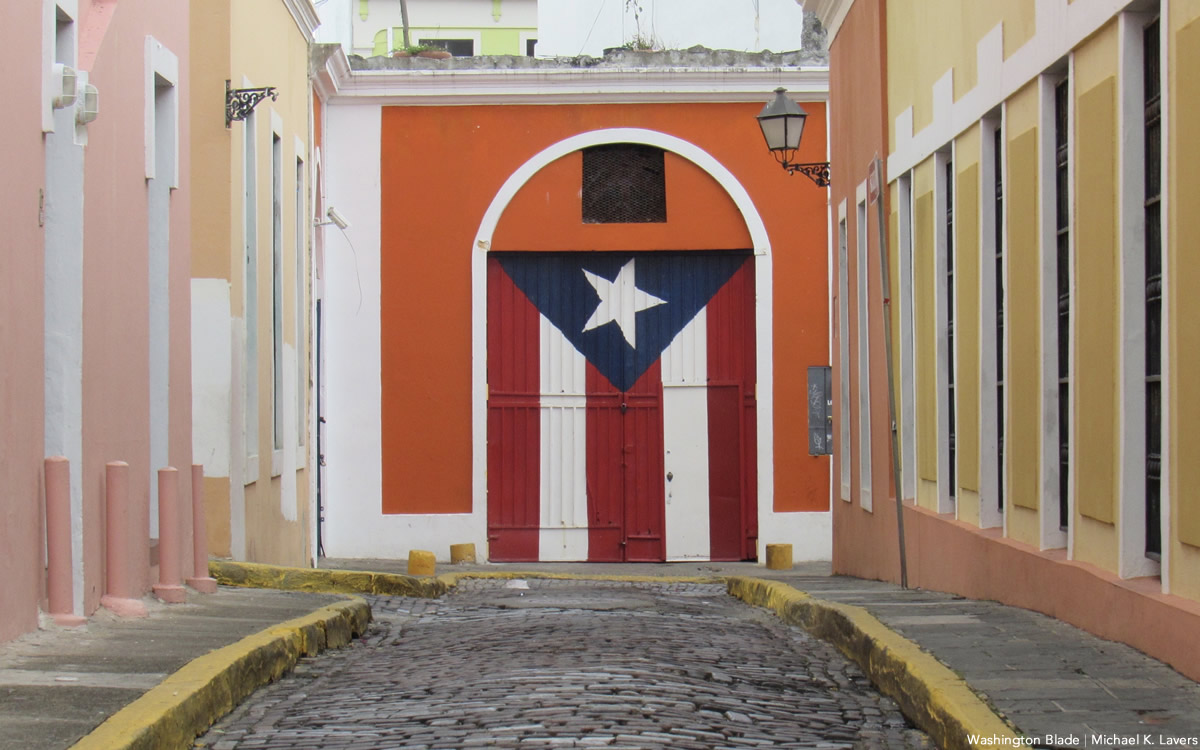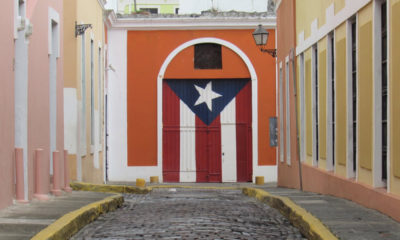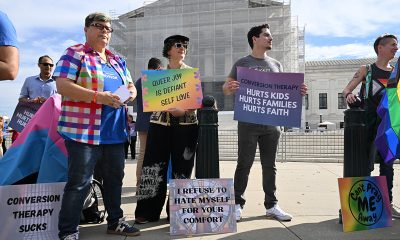Opinions
A failed commitment to promote LGBTQ-inclusive education in Puerto Rico
Island has highest rate of gender-based violence in country

Gender identity, gender expression, identity, biological identity, transgender women, trans masculinity and machismo, among other things, cannot be mentioned within Puerto Rico’s public system right now. Is this another version of Florida’s “Don’t Say Gay” bill? No, but it’s not too far from it. The above is happening in Puerto Rico, the territory with the highest rates of gender-based violence in the entire country.
Puerto Rico Education Secretary Eliezer Ramos on March 10 signed a circular letter (Number 032-2021-2022): Equity and respect among all human beings that create a curriculum of gender equity within the public instruction system. The approval of this circular letter happened after a written commitment adopted in the Executive Order 2021-013 from 2021, where Puerto Rico Gov. Pedro Pierluisi declared a state of emergency on the island because of gender-based violence. Puerto Rico has the highest rate of crimes against women, trans people and the LGBT+ community in the U.S. After the alarming rates on the island and years of continuous claims from human rights organizations, the government of Puerto Rico decided to declare an emergency in the territory.
The executive order from 2021 created the Committee for the Prevention, Support, Rescue and Education (PARE) to draft a curriculum to address gender-based violence. The purpose of the curriculum was to influence Puerto Rico’s public education system regarding inequity among genders and create a new interdisciplinary concept of a gender perspective for future generations. Unfortunately, Ramos didn’t sign a gender perspective education circular letter as required by Executive Order 2021-013, but issued a letter that does not meet the department’s current needs and our Puerto Rican society related to the gender-based violence that our island has been suffering for decades. It is just another useless public policy.
The recent approval of the circular letter is a mockery of a decade of effort and hard work from feminist organizations against gender-based violence and an apparent contradiction to the commitment made by Pierluisi to develop a curriculum with a gender perspective in the Jan. 25 executive order. When we speak of a gender perspective, we refer to a conceptual tool that seeks to show that the differences between women and men occur not only because of their biological determination but also because of cultural differences. The purpose of education with a gender perspective is to question the stereotypes with which we are educated and open the possibility of developing new concepts and solving the social imbalances between the genders. In short, the gender perspective seeks to modify the social structures that reproduce inequality, inequity, discrimination, prejudice, and violence; and achieve true gender equality. But to achieve this, it needs to be done in a transversal, intersectional, holistic and multidisciplinary way within the Department of Education. Not through another nice “statement.”
The circular letter approved on March 10 went from a curriculum that sought to address inequalities based on biological and cultural differences and gender identities to becoming one more public policy of values and principles. Everything changed when Ramos decided to negotiate with the senator of the Dignity Project (Religious Party), Joanne Rodríguez Veve, and the New Progressive Party (NPP). Among the changes achieved by the faith-based sector were ignoring and removing the existence of the concepts of gender expression and identities. According to the faith-based sector, concepts that promote homosexuality and distance us from the traditional (“normal”) family. The gender perspective, if approved, sought that our students could begin to educate themselves on the importance of understanding that there is nothing wrong with having gender identities that are not consistent with cultural concepts and stereotypes imposed on them by our society. An education that teaches us that colors, clothes, toys, jobs, sports, professional aspirations, behaviors, ways of speaking, expressing ourselves, walking, interacting, thinking, accessing services, strengths, access, learning, values, quality of a person, intelligence, thoughts and limitations should never be defined by your gender or your biology.
When we compare Republican states in the U.S., such as Florida, which recently passed legislation (“Don’t Say Gay”) that prohibits the use of the word “gay” in public institutions, you realize that Puerto Rico is not far from it. Why did Ramos agree to this negotiation? Why did he walk away from his true calling to do justice to our students? Was it a quid pro quo to be confirmed by Puerto Rico’s Senate? We don’t know. Unfortunately, today we go back again after so many years of effort and work. It is unfortunate that instead of choosing to change generations and create a better society, the secretary of education decided to continue perpetuating the ignorance of our culture. It is unfortunate that the secretary of education, instead of putting himself on the right side of history and with his actions helping to eradicate future gender-based violence based on a macho concept and patriarchy attached to our society, decided to look to the side. He chose to ignore the deaths of hundreds of women whose memories cry out for justice, natural justice, not fictitious, not another worthless piece of paper that will be useless like the thousands of circular letters approved by the department throughout the decades.
Opinions
Holidays not always bright for transgender people
‘Home’ often doesn’t feel like home for trans folks

Christmas is family time, isn’t it? It seems like every TV ad, every rom-com with a Christmas tree and fairy lights, every festive novel in your local bookshop is trying to persuade you of this. To push it on you — and what’s wrong with it, you may ask? Well, just think about the thousands of people who cannot spend this holiday season with their loved ones. Think about the transgender community specifically.
Even without the increasingly hostile political climate against trans people in modern-day America, many of them are not welcome in their own families. It is not something that started with MAGA, although MAGA certainly made it worse. “Home Alone” is not a comedy when your family does not accept you, and you are stuck all alone on Christmas. I’ve never been alone at holidays, but I know — as a trans person who has always loved family stories but estranged from their family — how the season can be tough.
Let’s make it clear: I like the holiday season, and I would never ask you to cancel it. I just want you to support your trans friends, and the trans community in general.
According to recent data from the Williams Institute at UCLA, more than 2.8 million people in the U.S. now identify as trans, including roughly 724,000 youth aged 13–17. And not all of them are out or accepted at home. That means many thousands are navigating teenage years — the years when so many family traditions, holidays, and emotional expectations are formed — while being invisible to their own families, or abused by them.
But for a large proportion of trans people, “home” doesn’t feel like home.
In the landmark 2015 U.S. Transgender Survey, many of respondents who were out to their immediate family reported some form of rejection: relationships ending, being kicked out, being denied the ability to express their gender, or being sent away.
Among those who did experience family rejection, 45 percent had experienced homelessness.
Other research shows how deeply rejection affects health: trans youth without family support face far higher rates of psychological distress, suicidality, and substance misuse.
So when you hear “Christmas is family time,” for many trans adults that message comes with flashbacks and pain. For trans kids it may be worse.
Also, intersectionality made everything even hard. Take trans people of color. A report on Black trans Americans found:
- 42 percent had experienced homelessness
- 38 percent lived in poverty
- Rates of sexual violence, mistrust of authorities, and fear of asking for help were also significantly higher
And if a trans person is also disabled, autistic, or living with chronic health conditions, the barriers become even bigger. Just imagine what it is like when your parents try to change you for being autistic all your childhood, and then kick you up for being trans. Ableism often goes hand in hand with transphobia; support systems become less accessible; and acceptance becomes harder to find. Holidays meant not just that you sometimes couldn’t share fun because of lack of inclusion now, but also because of mental health issues triggered by the past.
So yes — when you talk about Christmas stories of family, warmth, fairy lights and acceptance, it’s important to remember that for many trans people, Christmas is not something nice and cozy. Many trans people are suffering from PTSD, and for people with PTSD holidays are often a trigger.
So what can you do, as a trans ally or another trans person who wants to help their trans siblings? What does a “trans-friendly Christmas” look like for those estranged from their families?
Supporting a trans person at Christmas doesn’t have to be perfect. It doesn’t demand huge gestures, it doesn’t mean that you should stop celebrating or play Grinch. Just remember that not everyone is celebrating. And even people like me, who are celebrating, sometimes feel too triggered by all the perfect family pictures.
But there is some way to help your trans friends.
Give them space. Not everyone wants to talk about Christmas. Not everyone wants to explain their estrangement. They may withdraw, or avoid festive events entirely. Respect that. As an expert working with mental health services, I can say that sometimes the best gift is the room to breathe.
Say: “I know this time of year can be difficult. I’m here if you want to speak, and I’m here if you don’t.” Or share your own bad experience, especially if you are speaking with autistic person.
Or just ready to support them in a way they need.
Acknowledge the pain, without feeling guilty if it’s not your fault, and provide some support.
This might mean:
- Inviting them to your home for a meal
- Checking in with a simple, trans-friendly message (“thinking of you today — hope you’re doing whatever feels right for you”) — especially if they like this kind of messages
- Suggesting a walk, a film night, or anything that doesn’t revolve around “family”
- Bringing them into chosen family traditions if they’re open to it
- Support trans community online
- Just share photos of your pets
Be prepared for triggers. Really. I often have a relapse in my mental health on holidays despite liking them. Or, because I have Dissociative Identity Disorder, I struggle with my child’s personality. Your friends who have PTSD or DID can have similar problems. Respect them even if they behave “childishly” — even when a person is mentally falling into their child state, remember that they still have agency. Listen to their stories. Help them create their own holiday traditions if they need to, or ask for professional help. Be patient. Depression, anxiety, or OCD can also be triggered during holidays even if a person with those conditions is in remission.
And, most important of all: listen.
Some trans people want community on Christmas. Some want silence. Some want to escape. Some want a tiny piece of normality. Some want their own queer or geeky Christmas. Some prefer to celebrate the new year. There is no universal script. Let them decide. And remember: support is the most important thing.
Not the holiday decorations. Not the perfectly curated “inclusive holiday.” Not expensive parties.
Because for many trans people who have lost their family, especially at Christmas, it is important to know that someone sees them, someone calls them by their chosen name, someone cares, someone wants them here even if their parents don’t.
And sometimes, that’s enough to make the season not just survivable, but enjoyable. This, by the way, is true for all holidays, whether it’s Hanukkah or New Year’s Eve.
Opinions
Reflecting on six years on the CAMP Rehoboth board
Purpose, people, and the power of community

Some people let life happen; I prefer to plan it—meticulously, intentionally, and yes, sometimes overboard. After losing many loved ones and navigating my own setbacks, I learned not to let life drift by; instead, I live it with intention—curating the people, commitments, and actions that bring joy and meaning, even if others mistake that intentionality for control.
True to form, I close each year with an annual life audit reflecting to see if my personal goals were achieved and, if not, why did I fall short. This habit reflects a simple philosophy: fulfillment doesn’t happen by accident. It comes from daring to imagine the life you want and living deliberately at work, in service to others, and in the everyday moments that make life meaningful.
This year’s assessment is a bit more complicated because on Dec. 31 I will conclude six years on the board of CAMP Rehoboth Community Center — two full three-year terms, including three years as board president. When putting pen to paper, I quickly realized the lessons from the last 12 months were six years in the making.
For those who may not know, CAMP Rehoboth (CAMP is an acronym for Create A More Positive) is widely recognized as the leading provider of life-affirming programs and services in support of LGBTQ people in Rehoboth Beach, Del., and the greater Sussex County area. Since its founding 34 years ago, CAMP’s work has enabled LGBTQ people to thrive. In fact, it is the reason my husband Greg and I (along with thousands of other LGBTQ people) decided to make this part of Delaware our home.
If the past few years have taught me anything, it is that leadership is not a position—it is a practice. It is a daily decision to show up with clarity, steadiness, and a willingness to hold space for others as we navigate change together.
Purpose is the compass. Purpose gives direction when circumstances shift, resources tighten, and competing demands threaten to pull us off course. At CAMP Rehoboth, our purpose has always been to ensure LGBTQ people have access to life-affirming programs, culturally competent services, and a place where they feel seen, valued, and supported. Purpose guided our leadership transition and executive director search, reminding us that the leader our community deserves must bring experience, emotional intelligence, and a deep understanding of what belonging means.
Values are the guardrails. They keep us aligned when opportunities, distractions, or pressures arise. Our values show up in our strategic planning, financial stewardship, and insistence that inclusion is a practice, not a slogan. They ensure that when challenges—political hostility, funding uncertainty, changing community needs—emerge, we respond with integrity instead of reaction.
People are the engine. Organizations don’t create impact — people do. Staff, volunteers, board members, donors, and community members together make the mission real. Investing in their capacity, wellness, and professional development ensures they can do their best work. When we take care of our people, they take care of the community.
I am a gay man who knows how obstacles can feel insurmountable and hope can falter having lived through the AIDS epidemic and fought for civil rights like the legalization of same-sex marriage. In those moments, I chose to focus on what I could control rather than what I could not. Getting involved gave me purpose and proved that fulfillment comes from taking action to make a difference—for yourself and for the broader community.
Gratitude is the culture.
As I close this chapter, what I feel most is gratitude. Gratitude honors those who built the foundation, celebrates those who carry the work forward, and reminds us that progress is a collective effort. Thank you to our staff, especially Executive Director Kim Leisey, who serve with skill and heart; to our volunteers like former board member Chris Beagle and current board president Leslie Ledogar, who give more than anyone will ever know; to our donors, who invest in possibility; and to the community that trusts us to be there in moments of celebration, struggle, and change. Finally, none of this would have been possible without the steadfast love of my husband and the unwavering support of close friends who lifted me in the moments I needed it most.
Reflection, planning, and intentionality do not guarantee perfection — but they make fulfillment possible. Life is too short to leave it to chance. By daring to dream, acting deliberately, and giving generously, we can create lives that are both meaningful and impactful — not just for ourselves, but for the communities we touch.
Wes Combs is an outgoing board member of CAMP Rehoboth.

Trump saw the writing on the wall with regard to releasing the Epstein files. He tried to get ahead of the parade by asking Republicans to vote for release, instead of facing his biggest embarrassment when they were going to anyway. Then there were the major Republican losses in the last election. Now House Armed Services Committee Chair Mike Rogers (R-Ala.), and Senate Armed Services Committee Chair Roger Wicker (R-Miss.), and their Democratic ranking members, are investigating the Pentagon after it was reported Secretary of Defense Pete Hegseth potentially committed a war crime with regard to the bombing of boats suspected of running drugs. It really seems we are seeing the beginning of the fall of Trump.
That’s not to say the felon doesn’t continue to have the power to screw the country, and the world. He does. Those around him like Vought at OMB, and his personal Goebbels, Stephen Miller, will push him harder to advance Project 2025 before the mid-term elections. There are so many things in that 900-page document that have yet to be perpetrated on the American people. I am sure the felon doesn’t know half of them, as one can be quite confident, he never read it. Each day we wake to some new outrage by the grifter in the White House. His family cutting deals with the Saudis, upping and lowering tariffs as the mood strikes. Not in a rational way because they have already proven to be a disaster for the American people. Then the continuing destruction of our healthcare system by RFK Jr.
Then the felon threatens Venezuela, and illegally declares the airspace around it closed. The felon threatens Indiana Republican legislators who don’t go along with his request for redistricting, with primaries. A judge in Texas rules their redistricting is illegal, though the Trump Supreme Court did overrule that. He calls Marjorie Taylor Green a traitor, then his MAGA cult threatens her life. She resigns. He does the same to Democratic legislators who made a video telling the military they do not have to obey unconstitutional orders. The felon called that “SEDITIOUS BEHAVIOR, punishable by DEATH!” He went further and reposted a Truth Social post that read “HANG THEM GEORGE WASHINGTON WOULD !!” This now has his MAGA base threatening their lives. They are not resigning. All of this adding to the feeling his acts, and statements, clearly reek of desperation.
He continues to blame Biden, nearly a year after taking office, for his own failures. He blames Biden for not vetting the Afghani immigrant who shot the two National Guard members from West Virginia patrolling D.C. This, while it was his administration, that granted him asylum without any vetting, in April.
I find it incomprehensible there are still some people, who can’t, or don’t, want to understand attacking Democrats for what is going on today, makes no sense, when the felon controls the White House, Congress, and the Supreme Court. Staying home, or voting for third party candidates, with no chance of winning, is like voting for the Republican. In the recent elections we began to see those who don’t like what is happening, wake up. They realize only a vote for a Democrat will make a difference. We saw that across New York, New Jersey, Pennsylvania, Virginia, and Georgia.
As we approach the midterm elections, I plead with those who are not there yet, look at history, count how many independents were ever elected to Congress. In our system that rarely happens. Wishful thinking doesn’t win elections. Yes, I want Congress to look younger. I am happy Nancy Pelosi (D-Calif.), and Jerald Nadler (D-N.Y.), among others, have retired, allowing for primaries in their districts. I could name a few more in safe Democratic seats who I hope do the same. While not in office, young people should appreciate those who retire, might still have some wisdom from their years of service to share.
The young aren’t compelled to listen, yet someone like Pelosi, with her vast experience, could help a new person as they run to win, and then navigate the halls of Congress. If you look at all the demonstrations against the felon, and his administration, the age of the people demonstrating often skews older. Those like me have the time to demonstrate, and we do. We want to see the felon fall, and will work hard to make it happen. While too old to run for office, I will continue to voice my opinions. I will even endorse candidates I like. I suggest to all candidates it is important to do more than talk in generalities. You need an issues section on your website. Tell voters what you will do when elected. What bills will you introduce, which ones will you support. That may be old-fashioned, but it’s still important. And definitely be clear which party you will support if elected. I know, another old-fashioned idea.
As the felon continues to lose the support of the American people, I see young people begin to move to the Democratic Party, realizing if they step up to be counted, it will make a difference for their future. If this trend continues, I believe we are headed toward a better time in America.
Peter Rosenstein is a longtime LGBTQ rights and Democratic Party activist.
-

 Congress5 days ago
Congress5 days agoEXCLUSIVE: George Santos speaks out on prison, Trump pardon, and more
-

 The White House5 days ago
The White House5 days agoWhite House deadnames highest-ranking transgender official
-

 The White House4 days ago
The White House4 days agoAs house Democrats release Epstein photos, Garcia continues to demand DOJ transparency
-

 Opinions4 days ago
Opinions4 days agoReflecting on six years on the CAMP Rehoboth board




















